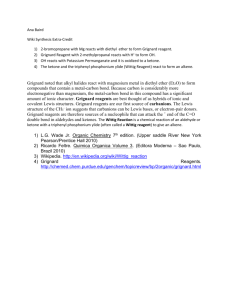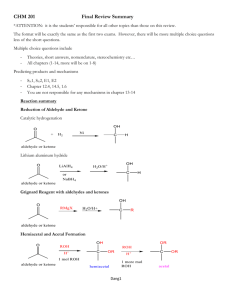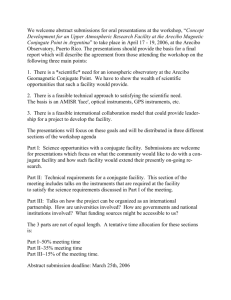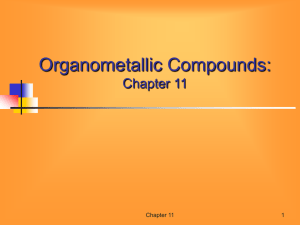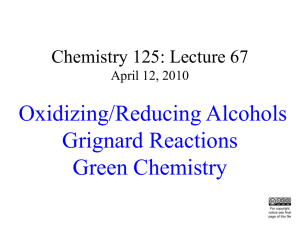Chapter 7 Copper Catalyzed Asymmetric Conjugate Addition of
advertisement
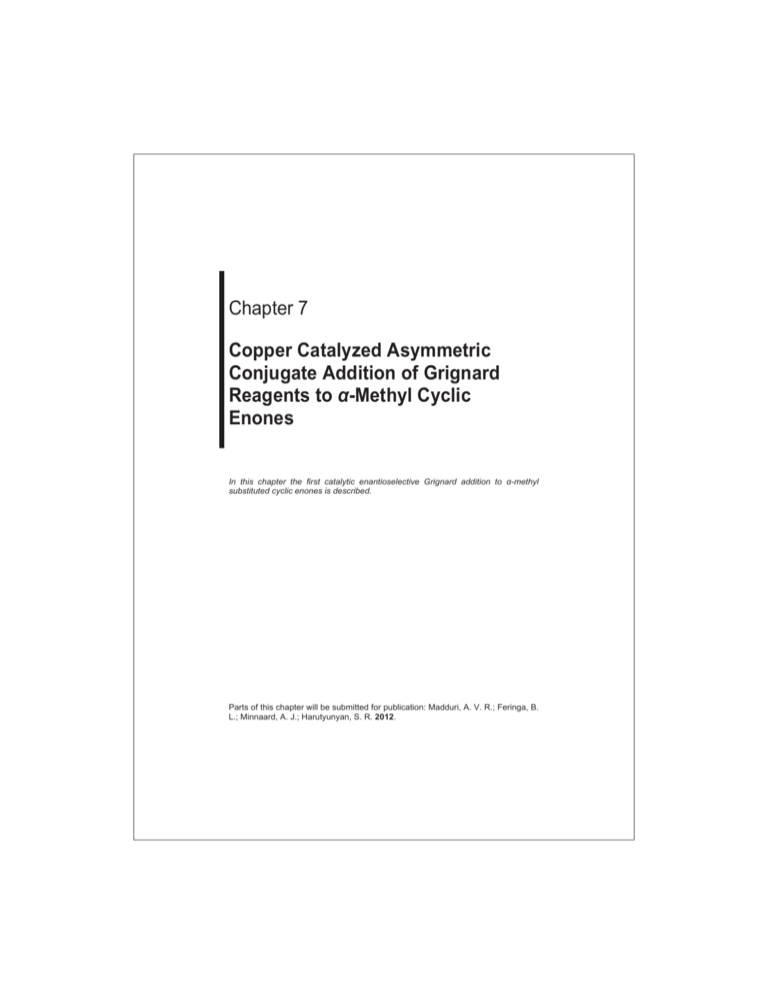
Chapter 7 Copper Catalyzed Asymmetric Conjugate Addition of Grignard Reagents to Į-Methyl Cyclic Enones In this chapter the first catalytic enantioselective Grignard addition to Į-methyl substituted cyclic enones is described. Parts of this chapter will be submitted for publication: Madduri, A. V. R.; Feringa, B. L.; Minnaard, A. J.; Harutyunyan, S. R. 2012. Chapter 7 7.1 Introduction The stereoselective formation of two chiral centers in one step is a rewarding process in synthetic organic chemistry. In principle, asymmetric conjugate addition reactions, such as the copper-catalyzed addition of organometallics, are suitable for this goal.1-4 A logic approach in this regard is to trap the enolate, resulting from the addition reaction, with an electrophile to create two stereocenters in one step. For cyclic enones, like cyclohexenone, this reaction is known for a long time, and leads to reasonable, though not excellent, stereoselectivities (Scheme 1).5-8 More recently, also linear substrates have been used with success, a special mention deserves the conjugate addition-aldol reaction to Į,ȕ-unsaturated thioesters by Howell et al.9 Scheme 1: Enolate trappings with electrophiles An obvious alternative is the asymmetric conjugate addition to substrates that already have a substituent ( H) at the Į-position. This has turned out, however, to be a remarkably difficult reaction to achieve.10-13 The copper-catalyzed asymmetric conjugate addition to unsaturated malonates is known,14 as well as scattered reports on other doubly activated Michael acceptors.15,16 Only recently, however, the first report on the successful conjugate addition to 2-methyl cyclohexenone appeared from the group of Alexakis, using trialkylaluminum reagents (Scheme 2).17,18 The reason for the reluctant behavior of 2-methyl cyclohexenone, compared 178 Conjugate addition of Grignard to Į-substituted enones O + R3Al CuTC 2 mol% Ligand 2 4 mol% Et2O, -30 oC, 18 h R = Et and Me O R dr's = up to 77:23 ee's up to 93% O P N O (Ra,Sc,Sc)-Phosphoramidite 2 Scheme 2: Cu-catalyzed asymmetric 1,4-addition of trialkylaluminium reagents with a copperphosphoramidite catalyst to cyclohexenone, in asymmetric conjugate addition reactions could be the attenuated coordination of the copper catalyst to the enone.19 Moreover, the formed enolate during the conjugate addition reaction of 2-methyl cyclic enones can result in two diastereomeric products, trans and cis, upon electrophilic quenching, in this case protonation. In most cases the thermodynamically favored trans product was observed as a major product.17 Very importantly, when the enolate is quenched with electrophiles other than a proton this leads to valuable quaternary stereo centers in the resulting product. Next to the Cu-catalyzed conjugate addition of diorganozinc and triorganoaluminum reagents, the use of Grignard reagents in this reaction is important, mainly because of the availability of the latter. A representative example uses Cu-TaniaPhos as the catalyst, as depicted in Scheme 3.20 This reaction is especially suited for the addition of alkyl Grignard reagents, leading to the corresponding chiral conjugate addition products in high yields and with excellent enantiomeric excess. 179 Chapter 7 Scheme 3: Cu-catalyzed asymmetric 1,4-addition of Grignard reagents with TaniaPhos The advantage of using Grignard reagents, prompted us to study whether this reaction could be used for the conjugate addition to D-alkyl substituted cyclohexenone as well.2 As shown in the previous chapters, the combination of CuBr with rev-JosiPhos catalyzes the 1,2-addition of Grignard reagents to Įmethyl-substituted acyclic enones providing tertiary allylic alcohols with enantioselectivities up to 96% (Scheme 4).21 Surprisingly, in the course of this study, we found that the corresponding Į-methyl-substituted cyclic enones gave conjugate addition products with promising stereoselectivities. Scheme 4: Catalytic asymmetric 1,2-additon to Į-substituted Į,ȕ-unsaturated ketones 7.2 Results and Discussion With this result in hand, we further explored this reaction by varying the ligand and the Grignard reagent. The first step was to identify the influence of the structure of 180 Conjugate addition of Grignard to Į-substituted enones the ligand, and the preference for 1,4-addition over 1,2-addition (Table 1). In addition to the formation of the desired 1,4-product 3 via conjugate addition, the Grignard reagent can enolise the substrate 1, form via ȕ-hydride transfer the corresponding secondary alcohol 5, or lead to the 1,2-product 4 via direct addition.22 Literature precedent shows that the ligand as well as the substitution pattern of the substrate plays a decisive role in the preference for these pathways.23 Therefore, the substrate 2-methylcyclohex-2-enone 1 was studied in the copper catalyzed addition of ethylmagnesium bromide with a range of ferrocenyl diphosphine ligands24 and other chiral ligands. By using the established copper-catalyzed 1,2-addition conditions we were pleased to find that in the presence of 5 mol% CuBr•SMe2/L1, the reaction proceeded with excellent 1,4regioselectivity and an ee of 40% for product 2 (Table 1, entry 1). In the presence of 5 mol% of a copper(I) salt only, the reaction proceeded with complete lack of chemoselectivity providing a mixture of products (Table 1, entry 2). This shows the influence of the chiral ligand on the chemo- and regioselectivity. Subsequently, ligands and copper precursors were varied, the results of which are presented in Table 1. Ligand L2 in combination with copper iodide showed to be promising in asymmetric conjugate addition reactions. This catalyst in the present conjugate reaction proceeds with moderate selectivities (entry 3). Further, L3/CuCl has shown excellent results in the asymmetric conjugate addition of Grignard reagents to cyclic enones.20 However, L3/CuCl and L3/CuBr•SMe2 at different reaction temperatures gave only modest regioselectivities and racemic product (entries 47). The reaction performed with ligand L5 (Josiphos)/CuBr·SMe2 proceeded with good regioselectivity and poor enantioselectivities for the both 1,2 and 1,4 adducts (Table 1, entries 8). As phosphoramidite ligands had shown to be successful in the conjugate addition of trialkylaluminum reagents by Alexakis and coworkers,17,25 also these were incorporated in the screening but without success (entries 9 and 10). A further screening of several other ligands L7-L10 (entries 11 and 14) did not show good results as well, compared to rev-JosiPhos L1. It is clear that both in terms of 1,4-selectivity and stereoinduction, ligand L1/CuBr•SMe2 is remarkably effective compared to other members of the ferrocenyl ligand family as well as to biaryl-based chiral ligands L2, and L8. 181 Chapter 7 EtMgBr Copper salt 5 mol% Ligand 6 mol% O O OH HO + + tBuOMe, -78 oC 3a 1,4-product 1 4 1,2-product 5 1,2-reduction Table 1: 1,4-addition of Grignard reagents to 2-methylcyclohex-2-enone 1 with various ligands Ligands Ph2P Me2N Ph2P Cy2P Rev-Josiphos (S,RFe)-L1 PCy2 Ph2P (Tol)2P (Tol)2P Fe Fe Fe JosiPhos (R,SFe)-L4 TaniaPhos (R,RFe)-L3 (R)-TolBinap L2 PPh2 P(tBu)2 O P N O O P N O (Sa,Sc,Sc)-Phosphoramidite L5 PPh2 Fe (Ra,Sc,Sc)-Phosphoramidite L6 Josiphos-type (R,SFe)-L7 F3C Me2N Ph2P Ph2P PPh2 PPh2 MeO MeO Meo-Biphep-type R-L8 Entrya Ligand CF3 Fe Fe P CF3 Me2N Ph P 2 Walphos-type (R,RFe)-L10 Mandyphos-type (R,SFe)-L9 Copper salt 3a:4:5 F3C trans/cis ratio, ee of major trans isomer 3ab,c 1 182 L1 CuBr•SMe2 96:3:1 81/19, 40% Conjugate addition of Grignard to Į-substituted enones 2 - CuBr•SMe2 38:56:6 - 3 L2 CuI 73:26:1 80/20, 21% 4 L3 CuCl 29:62:9 59/41, 0% 5d L3 CuCl 42:56:2 66/44, 0% 6 L3 CuBr•SMe2 35:64:1 79/21, 0% 7d L3 CuBr•SMe2 21:79:0 74/26, 0% 8 L4 CuBr•SMe2 61:37:2 79/21, 9% 9 L5 CuBr•SMe2 94:5:1 80/20, 4% 10 L6 CuBr•SMe2 91:9:0 81/21, 10% 11 L7 CuBr•SMe2 65:32:3 80/20, 8% 12 L8 CuBr•SMe2 91:6:3 80/20, 25% 13 L9 CuBr•SMe2 94:4:2 80/20, 3% 14 L10 CuBr•SMe2 95:5:0 79/21, 6% 15e L1 CuBr•SMe2 96:3:1 81/19, 36% a Conditions: 5 mol% copper salt, 6 mol% Ligand, 1.3 eq of RMgBr (3 h addition time), 0.1 M in tBuOMe, b c All conversions determined by (GC-MS). Regio- and enantioselectivities were –78 °C, 5-10 h. d o e determined by GC-MS and chiral GC of the crude Reaction performed at 10 C. RMgBr (15 min addition time). The influence of the solvent on the selectivity of the 1,4-addition was studied with the CuBr•SMe2/L1 catalyst. This revealed that ethereal solvents were superior both in terms of regio- and stereoselectivity of the reaction. tBuOMe was the solvent of choice for further studies, as in the asymmetric 1,2-additions in the previous chapters. A small gain in chemo- and enantioselectivity was obtained by switching from direct to slow addition of the Grignard reagent (Table 1, entry 15). With these 183 Chapter 7 optimized conditions in hand (Table 1, entries 1), the scope of this new reaction was explored. Both 2-methyl-cyclohexenone 1, and 2-methyl-cyclopentenone 2 were investigated in the CuBr•SMe2/L1 catalyzed 1,4-addition reaction (Table 2). In this study we relied on conversions rather than on isolated yields because of the volatility of the products, that makes accurate determination of the yields very difficult. Interestingly, conjugate addition of ethylmagnesium bromide to 2 proceeds with an excellent conversion, a high regioselectivity in favor of the 1,4-addition and a rewarding enantioselectivity of 84% ee (Entry 2). When the reaction was performed at higher temperatures a drastic decrease in regio and enantioselectivity of the reaction was observed (Entry 3). With this promising result we further explore the scope of the reaction. 2-Bromo-cyclopentenone underwent conjugate addition reaction very smoothly but in very poor enantioselectivities (Entry 4).26 The addition of pentylmagnesium bromide proceed with a good regioselectivity of 88/12 and an excellent enantiomeric excess of 93% (Entry 5). Table 2: Conjugate addition of Grignard reagents to 2-methyl-cyclopentenone and 2-methylcyclohexenone a Entry n RMgBr 3:4:5 (%) trans/cis, ee of major trans isomer ee, (conversion) b,c,d of 3 1 1 96:3:1 3a 81/19, 40(94) 2 184 0 98:1:1 3b 90/10, Conjugate addition of Grignard to Į-substituted enones 84(96) 3e 99:0:1 0 3b 80/20, 70(98) 4f 0 95:3:2 3c 76/24, 8(95) 5e 0 99:0:1 3d 88/12, 93(98) MgBr 6 0 96:2:2 3e 87/13, 68(96)g 7 0 99:0:1 3f 84/16, 86(98) 8 1 89:11:0 3g 66/34, 0(81) 9 0 76:24:0 3h 82/18, 55(86) a b Conditions: 5 mol% CuBr•SMe2, 6 mol% L1, 1.3 eq of RMgBr, 0.1 M in tBuOMe, –78 °C, 5-10 h. c Conversions were determined by GC-MS. The high volatility of the products did not allow to completely remove the solvents after the chromatography, frustrating the determination of an accurate isolated d e yield. Regio and enantioselectivities were determined by GC-MS and chiral GC of the crude. Reaction o f g performed at –60 C. Reaction performed on 2-bromo-cyclopentenone. Isolated yield. 185 Chapter 7 Phenylethylmagnesium bromide was also employed in conjugate addition to 2 and proceeded with complete conversion and in good regioselectivity but a decreased enantioselectivity (Entry 6). As this product was less volatile, the isolated yield could be determined. This showed that the reactions go in virtually quantitative yield. Butenylmagnesium bromide was also employed successfully, installing a convenient handle for further functionalization, in high regio and enantioselectivity (entry 7). Addition of methylmagnesium bromide to 1 proceeded with a complete lack of enantioselectivity (Entry 8). Interestingly, however, the addition of methylmagnesium bromide to 2 resulted in the desired conjugate addition product in 55% ee (Entry 9). Probably due to the lower reactivity of MeMgBr, the reaction did not go to full conversion. As a comparable jump in ee is observed for the addition of ethylmagnesium bromide to 2, the conclusion is justified that L1 is especially suited for conjugate additions to the latter substrate. In the conjugate addition to cyclohexenone and cyclopentenone, according to literature mostly the opposite trend is observed. 7.3 Summary and concluding remarks The results obtained so far point at a remarkable regioselectivity in the conjugate addition of Grignard reagents to 2-methyl-cyclohexenone and 2-methylcyclopentenone using CuBr/L1, somewhat attenuated in the addition of MeMgBr. What is unique as well, are the synthetically useful enantioselectivities obtained for the addition of several Grignard reagents to 2-methyl-cyclohexenone and 2-methylcyclopentenone. Further research on this reaction should obviously aim at the expansion of the substrate scope. Also trapping of the enolate formed with an electrophile, not studied yet due to time constraints, will be very interesting as (all-carbon)quaternary stereocenters can be formed in this way. The current good-but-notexcellent preference for the trans isomer will be difficult to change as it fully depends on substrate control during the protonation of the enolate. The ratios observed in this study are comparable to those found in literature.17 7.4 Experimental section General Flash chromatography: Merck silica gel type 9385 230-400 mesh, TLC: Merck silica gel 60, 0.25 mm. Components were visualized by UV and Seebach’s reagent, 186 Conjugate addition of Grignard to Į-substituted enones a mixture of phosphomolybdic acid (25 g), cerium (IV) sulfate (7.5 g), H2O (500 mL) and H2SO4 (25 mL) or potassium permanganate staining. Progress and conversion of the reaction were determined by GC-MS (GC, HP6890: MS HP5973) with an HP1 or HP5 column (Agilent Technologies, Palo Alto, CA). High resolution mass spectra (HRMS) were recorded on a AEI-MS-902 and FTMS orbitrap (Thermo Fisher Scientific) mass spectrometer. 1H- and 13C-NMR were recorded on a Varian AMX400 (400 and 100.59 MHz, respectively) or a Varian Gemini 200, using CDCl3 as solvent. Chemical shift values are reported in ppm with the solvent resonance as the internal standard (CHCl3: G 7.26 for 1H, G 77.0 for 13C). Data are reported as follows: chemical shifts, multiplicity (s = singlet, d = doublet, t = triplet, q = quartet, br = broad, m = multiplet), coupling constants (Hz), and integration. Carbon assignments are based on APT 13C-NMR experiments. Optical rotations were measured on a Schmidt + Haensch polarimeter (Polartronic MH8) with a 10 cm cell (c given in g/100 mL). Enantiomeric excesses were determined by HPLC analysis using a Shimadzu LC-10ADVP HPLC equipped with a Shimadzu SPD-M10AVP diode array detector or by capillary GC analysis (HP 6890, CP-Chiralsil-Dex-CB column (25 m x 0.25 mm) or Chiraldex B-PM (30 m x 0.25 mm x 0.25 ȝm)) using a flame ionization detector. All reactions were carried out under a nitrogen atmosphere using oven dried glassware and using standard Schlenk techniques. tBuOMe and dichloromethane were dried and distilled from calcium hydride; toluene, THF and n-hexane were dried and distilled from sodium. All copper salts were purchased from Aldrich, and used without further purification. All Starting materials and EtMgBr, PentylMgBr Grignard reagents were purchased from Aldrich. All other Grignard reagents were prepared from the corresponding alkyl bromides and Mg activated with I2 in Et2O. Ligand L1-L4 and L7-L10 were purchased from Solvias ligand kit Phosphoramidite ligand L5 and L6 were prepared as reported in the literature.25 Racemic products were synthesized by reaction of the ketones 1 with the corresponding Grignard reagent, copper salt 10 mol% and 20 miol% triphenyl phosphine at rt in Et2O. Whenever the absolute configuration is indicated, the assignment was based on comparison with literature data on similar compounds. General procedures for the copper-catalyzed conjugate addition of Grignard reagents. Procedure A: A Schlenk tube equipped with septum and stirring bar was charged with CuBr•SMe2 (0.015 mmol, 3.08 mg, 5 mol%) and ligand L1 (0.018 mmol, 6 mol%). Dry tBuOMe (3 mL) was added and the solution was stirred under nitrogen atmosphere at rt for 15 min. Then, 1 or 2 (0.3 mmol in 1 mL tBuOMe) was added and the resulting solution was cooled to –78 °C. The corresponding Grignard reagent (0.36 mmol, 1.3 eq in Et2O) was diluted with tBuOMe (combined volume of 1 mL) under nitrogen and added to the reaction mixture over 3 h. Once the addition was complete, the reaction mixture was analyzed by TLC and GC-MS. The reaction was quenched by the addition of MeOH (1 mL) and saturated aqueous 187 Chapter 7 NH4Cl (2 mL) and the mixture was warmed to rt, diluted with Et2O and the layers were separated. The aqueous layer was extracted with Et2O (3 x 5 mL) and the combined organic layers were dried with anhydrous Na2SO4, filtered and the solvent was evaporated in vacuo. The crude product was purified by flash chromatography on silica gel using mixtures of n-pentane and Et2O as the eluent. Note: GC analysis was carried out to determine the 1,4-addition, 1,2-addition and 1,2-reduction ratio on a sample obtained after aqueous workup and extraction with Et2O, which was passed through a short plug of silica gel to remove copper residues. Procedure B: A Schlenk tube equipped with septum and stirring bar was charged with CuBr•SMe2 (0.015 mmol, 3.08 mg, 5 mol%) and ligand L1 (0.018 mmol, 6 mol%). Dry tBuOMe (3 mL) was added and the solution was stirred under nitrogen at room temperature for 15 min. Then, 1 or 2 (0.3 mmol in 1 mL tBuOMe) was added and the resulting solution was cooled to –60 °C. The corresponding Grignard reagent (0.36 mmol, 1.3 eq, in Et2O) was diluted with tBuOMe (combined volume of 1 mL) under nitrogen and added to the reaction mixture over 3h. Once the addition was complete, the reaction mixture was analyzed by TLC and GC-MS. The reaction was quenched by the addition of MeOH (1 mL) and saturated aqueous NH4Cl (2 mL) and the mixture was warmed to room temperature, diluted with Et2O and the layers were separated. The aqueous layer was extracted with Et2O (3 x 5 mL) and the combined organic layers were dried with anhydrous Na2SO4, filtered and the solvent was evaporated in vacuo. The crude product was purified by flash chromatography on silica gel using mixtures of n-pentane and Et2O as the eluent. Assignment of absolute configurations: The absolute configuration of all products was assigned by comparing the sign of the optical rotation to that of (+)-(2S,3R)-2,3-dimethylcyclopentanone (5)27-29 and (í)-(2S,3R)-3-ethyl-2-methylcyclohexanone (6)17 with known absolute configuration. Chiral GC conditions: The enantiomeric excess was determined by chiral GC (chiraldex G-TA Grace Alltech nt. 4139, 30 m, 0,25 mm, 0,125 μm), Detector FID. Temperature programs were as follows: initial temperature 95 oC, temperature gradient 4 oC/min 5 min hold time, 125 oC (1 oC/min) 7 min hold time, final temperature (130 oC (0.5 oC/min) 50 min hold time); retention time (RT) are given in min. 188 Conjugate addition of Grignard to Į-substituted enones (í)-(2S,3R)-3-ethyl-2-methylcyclohexanone (3a): Using method A: Reaction was performed with (S,RFe)ligand L1 and EtMgBr. Product 3a was obtained as a colorless oil 96:3:1 mixture of 3a, 4a, and 5a after column chromatography (SiO2, n-pentane:Et2O 90:10), [94% conversion, trans/cis 81/19, 40% ee major trans diastereomer, 38% ee minor cis diastereomer]. The high volatility of the product 3a did not allow complete removal of the solvents after the chromatography, hampering the determination of an accurate isolated yield. The spectral data were identical in all respects to those previously reported.17 [Į]D20 = +5.2 (c = 1.3, CHCl3), [lit.17 (82% ee): [Į]D20 = í12.7 (c = 1.29, CHCl3) for trans 2R,3S]. Retention times on chiral GC for the major trans diastereomer: 4.4 min (major), 4.6 min (minor)]. (+)-(2S,3R)-3-ethyl-2-methylcyclopentanone (3b): Using method A: Reaction was performed with (S,RFe)ligand L1 and EtMgBr. The product was isolated as a colorless oil in a 98:1:1 mixture of 3b, 4b, and 5b after column chromatography (SiO2, n-pentane:Et2O 90:10), [96% conversion, trans/cis 90/10, 84% ee major trans diastereomer, 81% ee minor cis diastereomer]. The high volatility of the product 3b did not allow to completely remove the solvents after the chromatography, hampering the determination of an accurate isolated yield. Traces of Et2O were present in the NMR spectra. 1H NMR (400 MHz, CDCl3) mixture of diastereomers į 2.23 – 2.07 (m, 1H), 2.04 – 1.87 (m, 2H), 1.66 – 1.47 (m, 2H), 1.46 – 1.29 (m, 1H), 1.23 – 1.09 (m, 2H), 0.88 (dd, J = 6.9, 2.5, 3H), 0.80 (t, J = 7.4, 3H). 13C NMR (101 MHz, CDCl3) trans diastereomer including Et2O į 220.53, 49.94, 46.19, 37.02, 26.85, 26.45, 12.34, 11.13. 13C NMR (101 MHz, CDCl3) cis diastereomer į 220.56, 49.07, 46.65, 35.81, 24.89, 21.82, 11.91, 9.29. [Į]D20 = +84.1 (c = 2.5, CHCl3). HRMS (ESI+, m/z): calcd for C8H14ONa [M+Na]+: 149.09369; found: 149.09371. Retention times on chiral GC for the major trans diastereomer 2.8 min (major), 2.9 min (minor)]. (+)-(2S,3R)-2-methyl-3-pentylcyclopentanone (3d): Using method A: Reaction was performed with (S,RFe)ligand L1 and pentylmagnesium bromide. Product 3d was obtained as a colorless oil in a 99:0:1 mixture of 3d, 4d, and 5d after column chromatography (SiO2, pentane:Et2O 90:10), [98% conversion, trans/cis 88/12, 93% ee for the major trans diastereomer]. The high volatility of the product 3d did not allow complete removal of the solvents after chromatography, hampering the determination of an accurate isolated yield and traces of Et2O are present in NMR spectra. 1H NMR (400 MHz, CDCl3) mixture 189 Chapter 7 of diastereomers į 2.38 – 2.27 (m, 1H), 2.09 (m, 2H), 1.72 – 1.52 (m, 3H), 1.36 – 1.21 (m, 8H), 1.04 (d, J = 6.7, 3H), 0.88 (t, J = 8.1, 3H). 13C NMR (101 MHz, CDCl3) major trans diastereomer į 221.51, 50.49, 44.82, 37.40, 34.40, 32.05, 27.23, 26.75, 22.60, 14.03, 12.67. [Į]D20 = +27.7 (c = 1.1, CHCl3). HRMS (ESI+, m/z): calcd for C11H20O+Na [M+Na]+: 191.14064; found: 191.14069. Retention times on chiral GC for the major trans diastereomer 34.5 min (major), 36.6 min (minor)]. (+)-(2S,3R)-2-methyl-3-phenethylcyclopentanone (3e): Using method A: Reaction was performed with (S,RFe)ligand L1 and phenethylmagnesium bromide. Product 3e was obtained as a colorless oil in a 96:2:2 mixture of 3e, 4e, and 5e after column chromatography (SiO2, npentane:Et2O 97:03), [96% yield, trans/cis 87/13, 68% ee major trans diastereomer, 67% ee minor cis diastereomer]. 1H NMR (400 MHz, CDCl3) mixture of diastereomers į 7.31 – 7.25 (m, 2H), 7.18 (dd, J = 11.6, 4.3, 3H), 2.84 – 2.56 (m, 2H), 2.36 (dd, J = 18.8, 8.6, 1H), 2.27 – 2.17 (m, 1H), 2.06 (m, 2H), 1.80 – 1.54 (m, 3H), 1.50 – 1.38 (m, 1H), 1.06 (d, J = 6.7, 3H). 13C NMR (101 MHz, CDCl3) trans diastereomer į 220.94, 142.13, 128.87, 126.10, 50.43, 44.36, 37.39, 36.36, 33.46, 27.17, 12.58. 13C NMR (101 MHz, CDCl3) cis diastereomer į 221.39, 128.48, 128.27, 125.91, 46.64, 39.51, 36.31, 34.02, 31.36, 25.57, 9.82. [Į]D20 = +8.5 (c = 1, CHCl3). HRMS (ESI+, m/z): calcd for C14H18O+H [M+H]+: 203.1430; found: 203.1430. Retention times on chiral GC for the major trans diastereomer 43.3 min (major), 44.2 min (minor)]. (+)-(2S,3R)-3-(but-3-en-1-yl)-2-methylcyclopentanone (3f): Using method A: Reaction was performed with (S,RFe)ligand L1 and but-3-en-1-ylmagnesium bromide. Product 3f was obtained as a colorless oil in a 99:0:1 mixture of 3f, 4f, and 5f after column chromatography (SiO2, npentane:Et2O 90:10), [98% conversion, trans/cis 84/16, 86% ee major trans diastereomer, 84% ee minor cis diastereomer]. The high volatility of the product 3f did not allow complete removal of the solvents after the chromatography, hampering the determination of an accurate isolated yield and traces of Et2O were present in NMR spectra. 1H NMR (400 MHz, CDCl3) mixture of diastereomers į 5.76 – 5.58 (m, 1H), 4.99 – 4.73 (m, 2H), 2.26 – 2.16 (m, 1H), 2.12 – 1.92 (m, 4H), 1.73 – 1.45 (m, 3H), 1.24 (m, 2H), 0.93 (d, J = 6.6, 3H). 13C NMR (101 MHz, CDCl3) trans diastereomer į 220.40, 138.28, 114.58, 50.21, 44.05, 37.10, 33.63, 31.17, 26.92, 12.41. 13C NMR (101 MHz, CDCl3) cis diastereomer į 221.22, 138.09, 114.58, 46.49, 39.33, 35.95, 31.71, 28.40, 25.21, 9.57. [Į]D20 = +72.1 (c = 190 Conjugate addition of Grignard to Į-substituted enones 2.7, CHCl3). HRMS (ESI+, m/z): calcd for C10H16O+Na [M+Na]+:175.1093; found: 175.1093. Retention times on chiral GC for the retention time (RT) are given in min, major trans diastereomer 5.5 min (major), 5.7 (minor)]. (+)-(2S,3R)-2,3-dimethylcyclopentanone (3h): Using method B: Reaction was performed with (S,RFe)ligand L1 and MeMgBr. Product 3h was obtained as a colorless oil in a 76:24:0 mixture of 3h, 4h, and 5h after column chromatography (SiO2, n-pentane:Et2O 90:10), [86% conversion, trans/cis 89/11, 55% ee major trans diastereomer, 42% ee minor cis diastereomer]. The high volatility of the product 3g did not allow complete removal the solvents after the chromatography, hampering the determination of an accurate isolated yield. The spectral data were identical in all respects to those reported. 27,28 [Į]D20 = +81.6 (c = 1.8, CHCl3), [lit. (99% ee): [Į]D20 = +152 (c = 2, CHCl3)]. Retention times on chiral GC for the major trans diastereomer 1.8 min (major), 1.9 min (minor)]. 7.5 References (1) (2) (3) (4) (5) (6) (7) (8) (9) (10) (11) (12) (13) (14) (15) Jerphagnon, T.; Pizzuti, M. G.; Minnaard, A. J.; Feringa, B. L. Chem. Soc. Rev. 2009, 38, 1039. Harutyunyan, S. R.; den Hartog, T.; Geurts, K.; Minnaard, A. J.; Feringa, B. L. Chem. Rev. 2008, 108, 2824. Alexakis, A.; Bäckvall, J.-E.; Krause, N.; Pamies, O.; Dieguez, M. Chem. Rev. 2008, 108, 2796. Copper-catalyzed enantioselective conjugate addition reactions of organozinc reagents. In Modern Organocopper Chemistry.; Krause, N., Ed.; Wiley-VCH: Weinheim, Germany, 2002. Organocopper reagents, A Practical Approach; Taylor, R. J. K., Ed.; Oxford University Press: Oxford, 1995. Alexakis, A.; Trevitt, G. P.; Bernardinelli, G. J. Am. Chem. Soc. 2001, 123, 4358. Taylor, R. J. K. Synthesis 1985, 364. Naasz, R.; Arnold, L. A.; Pineschi, M.; Keller, E.; Feringa, B. L. J. Am. Chem. Soc. 1999, 121, 1104. Howell, G. P.; Fletcher, S. P.; Geurts, K.; ter, H. B.; Feringa, B. L. J. Am. Chem. Soc. 2006, 128, 14977. Alexakis, A.; Benhaim, C. Eur. J. Org. Chem. 2002, 2002, 3221. Krause, N.; Hoffmann-Röder, A. Synthesis 2001, 2001, 0171. López, F.; Minnaard, A. J.; Feringa, B. L. Acc. Chem. Res. 2006, 40, 179. P. Sibi, M.; Manyem, S. Tetrahedron 2000, 56, 8033. Superchi, S.; Marchitiello, V.; Pisani, L.; Scafato, P. Chirality 2011, 23, 761. Chiarucci, M.; Lombardo, M.; Trombini, C.; Quintavalla, A. Adv. Synth. Catal. 2012, 354, 364. 191 Chapter 7 (16) Alexakis, A.; Bäckvall, J. E.; Krause, N.; Pàmies, O.; Diéguez, M. Chem. Rev. 2008, 108, 2796. (17) Vuagnoux-d'Augustin, M.; Alexakis, A. Chem. Eur. J. 2007, 13, 9647. (18) d’Augustin, M.; Palais, L.; Alexakis, A. Angew. Chem. Int. Ed. 2005, 44, 1376. (19) Yoshikai, N.; Yamashita, T.; Nakamura, E. Chem. Asian. J. 2006, 1, 322. (20) Feringa, B. L.; Badorrey, R.; Peña, D.; Harutyunyan, S. R.; Minnaard, A. J. Proc. Natl. Acad. Sci. USA 2004, 101, 5834. (21) Madduri, A. V. R.; Minnaard, A. J.; Harutyunyan, S. R. Chem. Commun. 2012, 48, 1478. (22) Hatano, M.; Ishihara, K. Synthesis 2008, 11, 1647. (23) Deutsch, C.; Krause, N.; Lipshutz, B. H. Chem. Rev. 2008, 108, 2916. (24) Dai, L.-X.; Tu, T.; You, S.-L.; Deng, W.-P.; Hou, X.-L. Acc. Chem. Res. 2003, 36, 659. (25) Teichert, J. F.; Feringa, B. L. Angew. Chem., Int. Ed. 2010, 49, 2486. (26) Li, K.; Alexakis, A. Angew. Chem., Int. Ed. 2006, 45, 7600. (27) Lord, M. D.; Negri, J. T.; Paquette, L. A. J. Org. Chem. 1995, 60, 191. (28) Vuagnoux-d'Augustin, M.; Kehrli, S.; Alexakis, A. Synlett 2007, 2057. (29) Paquette, L. A.; Lord, M. D.; Negri, J. T. Tetrahedron Lett. 1993, 34, 5693. 192

